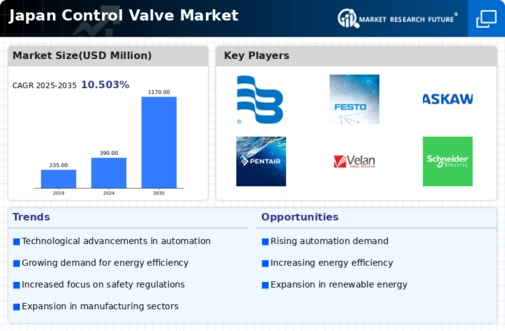Growing Energy Sector Demand
The energy sector in Japan is witnessing a resurgence, driven by the need for reliable and efficient energy solutions. This growth is significantly impacting the control valve market, as these valves are crucial for managing the flow of fluids in power generation and distribution systems. In 2025, the energy market is projected to grow by approximately 5%, leading to increased investments in control valve technologies. The shift towards renewable energy sources, such as wind and solar, further emphasizes the importance of control valves in ensuring optimal performance and safety. As the energy sector evolves, the control valve market is likely to see heightened demand for innovative solutions that cater to the specific needs of this dynamic sector.
Rising Industrial Automation
The control valve market in Japan is experiencing a notable surge due to the increasing adoption of industrial automation across various sectors. As industries strive for enhanced efficiency and productivity, the demand for automated control systems, including control valves, is on the rise. In 2025, the automation market in Japan is projected to reach approximately $10 billion, indicating a robust growth trajectory. This trend is particularly evident in manufacturing, where control valves play a critical role in regulating processes. The integration of advanced technologies, such as IoT and AI, further amplifies the need for sophisticated control valve solutions. Consequently, the control valve market is poised to benefit significantly from this automation wave, as companies seek to optimize operations and reduce operational costs.
Focus on Process Optimization
In Japan, the emphasis on process optimization across various industries is driving the demand for advanced control valve solutions. Companies are increasingly recognizing the importance of efficient process management to enhance productivity and reduce waste. The control valve market is benefiting from this trend, as these valves are integral to maintaining optimal operating conditions in manufacturing and chemical processing. In 2025, the market for process optimization technologies is expected to grow by 7%, indicating a strong correlation with the control valve market. As organizations seek to implement more sophisticated control strategies, the demand for high-performance control valves is likely to rise, presenting opportunities for innovation and growth within the industry.
Emergence of Smart Control Systems
The emergence of smart control systems is reshaping the landscape of the control valve market in Japan. With the advent of Industry 4.0, there is a growing trend towards integrating smart technologies into industrial processes. Control valves equipped with sensors and connectivity features are becoming increasingly popular, as they enable real-time monitoring and data analysis. This shift is expected to drive the control valve market forward, as companies seek to enhance operational efficiency and reduce downtime. In 2025, the market for smart control systems is projected to reach $5 billion, highlighting the potential for growth in this segment. As industries embrace digital transformation, the demand for intelligent control valve solutions is likely to expand, creating new avenues for manufacturers and suppliers.
Investment in Infrastructure Development
Japan's ongoing investment in infrastructure development is a key driver for the control valve market. The government has allocated substantial budgets for upgrading transportation, water supply, and energy systems, which necessitates the use of reliable control valves. In 2025, infrastructure spending is expected to exceed $200 billion, creating a favorable environment for the control valve market. Control valves are essential components in managing fluid flow and pressure in these systems, ensuring safety and efficiency. As new projects emerge, including smart city initiatives, the demand for advanced control valve technologies is likely to increase. This trend suggests a promising outlook for manufacturers and suppliers within the control valve market, as they align their offerings with the evolving infrastructure landscape.



















Leave a Comment